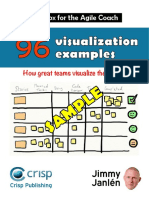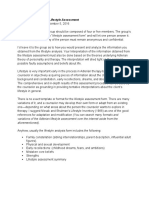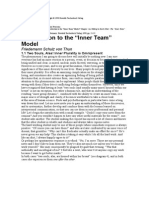Belbin Team
Belbin Team
Uploaded by
manique_abeyrat2469Copyright:
Available Formats
Belbin Team
Belbin Team
Uploaded by
manique_abeyrat2469Original Description:
Copyright
Available Formats
Share this document
Did you find this document useful?
Is this content inappropriate?
Copyright:
Available Formats
Belbin Team
Belbin Team
Uploaded by
manique_abeyrat2469Copyright:
Available Formats
CONTINUING PROFESSIONAL DEVELOPMENT
HOW TO BUILD A SUCCESSFUL TEAM
By Ruth McGuire, BSc
Providing effective health care often relies on good team work. This article explores team behaviour and suggests ways to
build a successful team
identify gaps in your
knowledge
1. What is the difference between a group and a team?
2. What are the key features of an effective team?
3. Which team role do you fulfil?
This article relates to the Royal Pharmaceutical Societys
core competencies of management and interpersonal
skills (see Medicines, ethics and practice a guide for
pharmacists, number 26, July 2002, pp1056). You should
consider how it will be of value to your practice.
ention the word team to people and they will probably think of sports, but the principles of team effectiveness are the same whether a team is based in the
work place or on a pitch. In Managing teams,1
Robert Heller says: A true team is a living, constantly changing,
dynamic force in which a number of people come together to work.
A successful team is more than just a collection of individuals: it has
synergy. That is to say, the achievement of the team is greater than
what the individual members of that team could produce on their
own.
A GROUP OR A TEAM?
It is important to understand the difference between a group and a
team. Groups tend to come together for a specific purpose but
members work independently. A group may have a leader, but the
roles and functions of the other group members are not well
defined. In contrast, an effective team has the following characteristics:
z Members who understand and commit to their role within the
team
z Shared sense of purpose
z Members who share and contribute to team goals
z Strong leadership
z Members who trust each other
z Members who support each other
z Good communication
z Ability to manage conflict when it arises
z Transparent decision making processes
ROLES WITHIN A TEAM
Many organisations use the Belbin team model to analyse their
teams. Dr Meredith Belbin defined team role as being about how
Ms McGuire is a journalist from West Yorkshire. She is also a lecturer and
trainer in personal development
814
identify
evaluate
record
plan
act
people behave in a team, how they contribute to a team and how
they interrelate with other team members. Having spent nine years
researching team behaviour, he concluded that a balanced team
exhibits nine roles (described in Panel 1 on p816) and that different
personalities naturally lean towards certain roles.
The nine roles can be grouped into three categories: action-oriented (people who take responsibility for tasks), people-oriented
(people who relate well to other people within the team) and cerebral (people who think creatively and analytically or contribute ideas
and knowledge). Each role contributes differently to the team, but is
also likely to be accompanied by typical weaknesses, which Belbin
describes as allowable.
Although a balanced team reflects all nine of Belbin's team
roles, this does not mean that a team must be composed of nine people. It just means that all nine roles must be covered in order for a
team to be most effective and many teams are composed of people
who carry out more than one Belbin role.
If a new team is being created from scratch, then consideration
needs to be given to filling the team with people who can bring characteristics of each of the nine roles to the team. For existing teams
that are not productive enough, certain members may need to be
replaced in order to ensure that all the Belbin roles are present within the team.
Belbin argues that understanding team roles is crucial to understanding team behaviour. When team members have a clear understanding of their own roles within a team and the teams goals, there
is a stronger sense of commitment.
SHARED SENSE OF PURPOSE
Although good teams work creatively, they need to have clear terms
of reference so that they understand what is expected of them and
know the limits of their responsibilities as a team. Teams are effective when members share a sense of purpose. In other words, when
they know where the team is going and why it exists.
Some teams even have a written mission statement to ensure
goals are clear. The achievement of goals often provides further
incentive for the team to continue working together. Goals should
be challenging and SMART (specific, measurable, agreed, realistic and timely) to help team members to keep focused and motivated. For a pharmacy team, goals might be to:
THE PHARMACEUTICAL JOURNAL (VOL 269)
7 December 2002
CONTINUING PROFESSIONAL DEVELOPMENT
z
z
z
z
z
z
z
z
Improve relationships with other health care professionals
Increase staff morale
Review existing procedures and reduce waiting times
Build better relationships with consumers
Provide training and development opportunities for all staff
Improve administrative systems
Improve the range of products
Meet financial targets
STRONG LEADERSHIP
The leadership style of the team leader will inevitably influence the
effectiveness of a team. Effective teams have strong leaders (Belbin's
co-ordinator role) and pharmacists are often expected to perform
this role. Some football teams are a good example of teams inspired
by good leaders (managers). They illustrate the importance of a
leader with vision. The leader must be able to implement decisions,
recruit new team members and select the best person to fulfil a particular role, ensure that individual team members are aware of their
responsibilities and raise the morale of the team when needed. An
effective team leader must take responsibility for the team achieving
its goals. When performance is poor, the leader takes the blame
because his or her role is seen as fundamental to team performance
and productivity. The leader should ensure that the team stays
focused on its work.
Good team leaders help team members to feel good about themselves. People almost always respond well to praise so it is important
for a team leader to give praise when it is due. However, going back
to the football team analogy, when goals are achieved, the success is
shared and celebrated by the entire team and not seen as an individual achievement. This is the same kind of team spirit that exists
within successful work-based teams. Where possible, team leaders
could try to build a reward system into the team structure for when
goals are achieved. Rewards used by organisations include pay rises,
bonus schemes, profit sharing and prizes. An effective team leader:
z
z
z
z
z
z
Can get people involved and committed
Makes it easy for others to see opportunities for teamwork
Allows people to perform
Looks for people who want to excel
Communicates fully and openly
Celebrates achievement
7 December 2002
TEAM TRUST
Trust is promoted through delegation, transparency and encouraging ideas. A good team leader delegates tasks to members and then
leaves them to take responsibility for those tasks. Interference (from
the leader or others) will leave a team member feeling that there is
no trust in his or her abilities to fulfil a role. A clear distinction needs
to be made between giving support and undermining a team member by trying to take over his or her task. If a task has been appropriately matched to a team member then delegation works well.
Allowing team members to develop can create trust and a team
leader should be on the look out for opportunities for individual
team members to grow, even if this means supporting a team member to apply for positions elsewhere.
The key to transparency is good communication. Teams usually
find that meetings are a good way of communicating effectively.
Meetings should be held regularly and include an agenda item on
progress reviews. Encouraging ideas during team meetings not only
helps members to feel valued but also to feel trusted. Furthermore,
meetings provide opportunities for teams to bond and friendships
can even be formed.
In Managing teams,1 Heller suggests that team members
should try to relate to each other as people and not just colleagues.
In other words, team members should not just work together but
play together in order to function more effectively as a team. Some
companies use away days as an opportunity to allow staff to discuss
action : practice points
1. Check the health of your team at w w w.teamcommunications.
com/team/teamcheck.htm
2. Identify your Belbin team role(s) and reflect on how you use
your role to contribute to your team's effectiveness.
3. Action plan to improve your teams effectiveness
evaluate
How could your learning have been more effective?
What will you do now and how will this be achieved?
THE PHARMACEUTICAL JOURNAL (VOL 269)
815
CONTINUING PROFESSIONAL DEVELOPMENT
work issues in a more relaxed environment. Often, leisure activities
or tasks that get people to work together in different ways are incorporated into the programme for the day.
regular basis. Team meetings provide an ideal opportunity for the
team to monitor its progress and to plan future goals. Meetings
should also be used by members to share their successes and provide
positive feedback on achievements.
TEAM COMMUNICATION
As already mentioned above, good communication is the lifeblood
of a successful team. This can be formal or informal. The frequency
of communication will often be determined by the distance between
team members. Research shows that the closer team members are to
each other in terms of where they sit, the greater their chances of
communicating. In larger premises, team members may not work in
a space where communication is only a matter of talking across a
short distance. Furthermore, in many places such as hospital pharmacies, team members will work different shifts, making regular
communication even more of a challenge. It is therefore important
for the team leader to choose the most effective method of communication for the team. This could be through traditional means such
as meetings, noticeboards, circulars, memos or electronic means
such as e-mails or an intranet. However, face-to-face communication is still the most effective means of communicating and some
arrangement should be made to allow staff physically to meet on a
PANEL 1: BELBINS TEAM ROLES
Plant A plant is creative, imaginative and unorthodox. He or she
solves difficult problems and comes up with ideas but can tend to
ignore incidentals and is often too pre-occupied to communicate
effectively
Co-ordinator A co-ordinator is mature, confident and a good
chairman. He or she clarifies goals, promotes decision-making,
delegates well, motivates others and makes the best of team
resources. However, a co-ordinator can be seen as manipulative
and may attempt to off-load personal responsibilities
Monitor evaluator Sober, strategic and discerning, the monitor
evaluator sees all options. He or she judges accurately and is
good at making decisions but lacks the drive and ability to
inspire others
Implementer Disciplined, reliable, conservative and efficient, an
implementer turns ideas into practical actions. He or she is a
good organiser but is somewhat inflexible and slow to respond to
new possibilities
Completer finisher A completer finisher is described as
painstaking, conscientious, anxious. This team member searches
out errors and omissions, delivers on time and pays attention to
detail but is inclined to worry unduly and is reluctant to delegate
Resource investigator Extrovert, enthusiastic, communicative
and adaptable, a resource investigator is good at exploring
opportunities and developing contacts. However, he or she can
be over optimistic and can lose interest once initial enthusiasm
has passed
Shaper A shaper is challenging and dynamic and thrives on
pressure. He or she is also highly motivated and has the
drive and courage to overcome obstacles but can be prone to
provocation and offending the feelings of others
Teamworker Co-operative, mild, perceptive and diplomatic, a
team worker is good at listening, building on ideas or suggestions and averting friction. However, team workers can prove
indecisive in crunch situations
Specialist Specialists are typically single-minded, self-starting
and dedicated. They provide knowledge and skills which are in
rare supply, but tend to dwell on technicalities and only
contribute on a narrow front
816
DEALING WITH TEAM CONFLICT
It is inevitable that at one time or another, there will be conflict
within a team. However, a disagreement should never be allowed to
reach the stage where it threatens the existence or success of a team.
Team leaders should always try to gather the facts and identify the
causes of a problem before reaching a judgement. Frequently, the
conflict will be resolvable but, in extreme cases, if a problem arises
because an individual does not contribute to the goals of a team, it
may be that his or her membership of the team needs to be reviewed.
The key point to resolving team conflict is to address the problem
rather than the person.
Although there may be a temptation to try to conceal or ignore a
problem, some management experts believe that it is far better to be
open about conflict because a problem within a team presents an
opportunity for learning rather than blaming. Some organisations
use a problem log. Using a log is a transparent process that allows
team members to offer suggestions for resolving problems. It
enables a problem to be clearly identified, its causes to be isolated,
the resources for resolving the problem to be identified, solutions to
be offered, and an action plan for implementing the solution outlined. The final outcome of the problem solving plan can also be
logged.
MEASURING SUCCESS
The success of a team should be measured at regular intervals so
that team spirit can be encouraged, either through celebrating
achievements or through sharing problems. In terms of measuring
success, it is perhaps easier to gauge the progress of a sports team
than it is to rate the performance of work-based teams, for example,
the performance of a sports team can usually be tracked by league
tables. Within the context of pharmacy, the measurement instruments will be determined by the goals set. For example, one goal
might be to increase profitability. This could be measured by looking at actual expenditure and profit versus forecasts. The progress of
a goal to increase morale could be assessed by conducting a staff survey.
CONCLUSION
Working as part of a successful team makes work enjoyable. It provides employees with a supportive work environment and enables
them to address any conflict that might arise in a constructive way.
Panel 2 suggests tips for team building.
PANEL 2: TIPS FOR TEAM BUILDING
z
z
z
z
Set SMARTgoals
Have regular away days
Share and celebrate team successes
Make sure team roles are matched to members interests and
skills
z Keep communication channels open and flowing
z Resolve conflict positively and learn from problems
z Have fun
REFERENCES
1.
Heller R. Managing teams. London: Dorling Kindersley;
1998.
FURTHER READING
z Maddux RB. Team building. 2nd Ed. London: Kogan Page;
1994.
THE PHARMACEUTICAL JOURNAL (VOL 269)
7 December 2002
You might also like
- Index Ventures Scaling Through Chaos N 1 Summary 1723659064Document12 pagesIndex Ventures Scaling Through Chaos N 1 Summary 1723659064Biruk GeneneNo ratings yet
- 2019 Global Skills Gap ReportDocument28 pages2019 Global Skills Gap ReportNaimul Kader100% (1)
- IPMA LEVEL C - Aug 2023Document4 pagesIPMA LEVEL C - Aug 2023hrishikesh anilkumar0% (1)
- All My Online Friends Are Better Than Me Three Studies About Ability Based Comparative Social Media Use Self Esteem and Depressive TendenciesDocument15 pagesAll My Online Friends Are Better Than Me Three Studies About Ability Based Comparative Social Media Use Self Esteem and Depressive TendenciesFOLKLORE BRECHÓNo ratings yet
- OCQDocument2 pagesOCQmanique_abeyrat246986% (7)
- A Guidebook of Program & Project Management For Enterprise Innovation International EditionDocument50 pagesA Guidebook of Program & Project Management For Enterprise Innovation International Editionpaula daniela rojas castroNo ratings yet
- 4 Political Frame WorksheetDocument4 pages4 Political Frame Worksheetapi-651856815No ratings yet
- Q1-Leadership Behaviour and Leader Self-Reported Well-Being - A Review - Integration and Meta-Analytic ExaminationDocument24 pagesQ1-Leadership Behaviour and Leader Self-Reported Well-Being - A Review - Integration and Meta-Analytic ExaminationHumberto Córdova TiconaNo ratings yet
- Operational Excellence Gap Analysis ToolDocument3 pagesOperational Excellence Gap Analysis ToolReyes Maria Kristina VictoriaNo ratings yet
- Future of HRDocument5 pagesFuture of HRbsushma23No ratings yet
- Research AssignmentDocument29 pagesResearch AssignmentUmar Hanif0% (1)
- Crestcom 2019 Ind FDD Complete PDFDocument206 pagesCrestcom 2019 Ind FDD Complete PDFmike mNo ratings yet
- 7 Questions - How Do You Create Clarity in Your Job and Those of Your Employees? The Importance of A Good Employee-Manager RelationshipDocument6 pages7 Questions - How Do You Create Clarity in Your Job and Those of Your Employees? The Importance of A Good Employee-Manager Relationshipram_babu_59No ratings yet
- 1flow of Primal LeadershipDocument5 pages1flow of Primal LeadershipLiberty CabanillaNo ratings yet
- RDF Schema - Syntax and Intuition: Werner NuttDocument52 pagesRDF Schema - Syntax and Intuition: Werner NuttAsHankSiNghNo ratings yet
- How To Establish Agile Competence Center Jovan VidicDocument1 pageHow To Establish Agile Competence Center Jovan VidicJovan VidicNo ratings yet
- 22 Practical Lessons of JorrDaar BookDocument111 pages22 Practical Lessons of JorrDaar BookRahul PattarNo ratings yet
- ReflectiveModelRolf6 PDFDocument2 pagesReflectiveModelRolf6 PDFsolar_powerNo ratings yet
- Emotional IntelligenceDocument15 pagesEmotional IntelligenceSurender Vijaykumar 11F 1691No ratings yet
- OEVE UT.2 Evaluation ActivityDocument4 pagesOEVE UT.2 Evaluation Activityzbyb97jnbsNo ratings yet
- Understanding The Attitude of Generation Z Towards WorkplaceDocument10 pagesUnderstanding The Attitude of Generation Z Towards WorkplaceKeeks MaveNo ratings yet
- Agiletoolbox Visualizationexamples SampleDocument20 pagesAgiletoolbox Visualizationexamples Samplefabio2006100% (1)
- The XP Lego GameDocument29 pagesThe XP Lego GameMaría Cecilia PeTriNo ratings yet
- Communication SkillsDocument9 pagesCommunication SkillsmiliamodesNo ratings yet
- Fast Forward 2021: Why The Future of Work Needs To Be MeaningfulDocument23 pagesFast Forward 2021: Why The Future of Work Needs To Be MeaningfulPandu PriambodoNo ratings yet
- The Psychological Aspects of Corporate ForesightDocument14 pagesThe Psychological Aspects of Corporate ForesightAladdin PrinceNo ratings yet
- Report Lifestyle AssessmentDocument1 pageReport Lifestyle AssessmentItang YonacNo ratings yet
- The Product/Market Fit Canvas: Quick GuideDocument9 pagesThe Product/Market Fit Canvas: Quick GuideJesús AlfredoNo ratings yet
- Ways To Use The LSIDocument9 pagesWays To Use The LSIWinner#1No ratings yet
- Psychometric Properties of The Defense Style Questionnaire (DSQ-40) in AdolescentsDocument8 pagesPsychometric Properties of The Defense Style Questionnaire (DSQ-40) in AdolescentsRolazski123No ratings yet
- Scalling TechniquesDocument33 pagesScalling Techniquesaniket yadav0006No ratings yet
- Real World Coaching Evaluation - 2010 Coaching Insight PDFDocument4 pagesReal World Coaching Evaluation - 2010 Coaching Insight PDFTeresita SotoNo ratings yet
- International Human Resource Management (Individual Assignment)Document15 pagesInternational Human Resource Management (Individual Assignment)Jamie LucasNo ratings yet
- Leadership Group Coaching in Action The Zen of CreDocument18 pagesLeadership Group Coaching in Action The Zen of Crewesal yousef ali faragNo ratings yet
- Bwl-Online Edu NeuDocument24 pagesBwl-Online Edu NeuGareth MaritzNo ratings yet
- Master Thesis Heinrich DornmayrDocument139 pagesMaster Thesis Heinrich DornmayrHeinrichNo ratings yet
- Organization Development and Change 10th 2015 BAB 2Document190 pagesOrganization Development and Change 10th 2015 BAB 2IndrabayuNo ratings yet
- Schulz Von ThunDocument1 pageSchulz Von ThunMarco Antonio Wong MorenoNo ratings yet
- Psychometrics of The Dyadic Coping Inventory in Three Language GroupsDocument13 pagesPsychometrics of The Dyadic Coping Inventory in Three Language GroupsIonela BogdanNo ratings yet
- How Leaders Create and Use NetworksDocument6 pagesHow Leaders Create and Use NetworksArbindchaudharyNo ratings yet
- Team Resilience PDFDocument9 pagesTeam Resilience PDFHamidah HamidNo ratings yet
- Outline For Course - Emotional IntelligenceDocument2 pagesOutline For Course - Emotional IntelligenceAkanksha Nagar-RM 20RM903No ratings yet
- Google PM 学习笔记C1-W1-W2Document3 pagesGoogle PM 学习笔记C1-W1-W2Yan Zhao100% (1)
- Chapter 14 - Eysenck - Cognitive Psychology A Students HandbookDocument21 pagesChapter 14 - Eysenck - Cognitive Psychology A Students HandbookMaría VélezNo ratings yet
- What Motivates Employees According To Over 40 Years of Motivation SurveysDocument18 pagesWhat Motivates Employees According To Over 40 Years of Motivation SurveysAhmed BilalNo ratings yet
- Marketing Mix 4C Robert Lauterborn, A Shift ParadigmDocument1 pageMarketing Mix 4C Robert Lauterborn, A Shift ParadigmSong BenjaminNo ratings yet
- Backcasting WorkshopDocument4 pagesBackcasting WorkshopTakis Ktenidis0% (1)
- How To Leverage OKR If Your Company Is Not GoogleDocument7 pagesHow To Leverage OKR If Your Company Is Not Googleميلاد نوروزي رهبرNo ratings yet
- WoopDocument2 pagesWoopapi-428138727No ratings yet
- Citavi 6 Getting StartedDocument4 pagesCitavi 6 Getting StartedAlexandru Stan100% (1)
- Scrum HandbookDocument66 pagesScrum Handbookmehul3685No ratings yet
- IntrapreneurDocument41 pagesIntrapreneurSuman SauravNo ratings yet
- Co Opetition: Barry Nalebuff Yale School of Management New Haven, CT 06520Document60 pagesCo Opetition: Barry Nalebuff Yale School of Management New Haven, CT 06520a_herdiansyahNo ratings yet
- Self As LearnerDocument10 pagesSelf As Learnerayan biswas100% (1)
- Collaborative Problem Solving: This Document Is Licensed Under A Creative Commons Attribution 3.0 LicenseDocument36 pagesCollaborative Problem Solving: This Document Is Licensed Under A Creative Commons Attribution 3.0 LicensePertosNo ratings yet
- Sacs Sub ScaleDocument2 pagesSacs Sub Scaleastridich100% (1)
- Generation Y in Business: Tips for building strong relationships between generationsFrom EverandGeneration Y in Business: Tips for building strong relationships between generationsNo ratings yet
- Group DynamicsDocument13 pagesGroup DynamicsMaynard ArandaNo ratings yet
- Leading and Building The Team in An EnterpriseDocument7 pagesLeading and Building The Team in An Enterpriseragidir265No ratings yet
- Ceo GlobalDocument17 pagesCeo Globalmanique_abeyrat2469No ratings yet
- Diversity ResistanceDocument1 pageDiversity Resistancemanique_abeyrat2469No ratings yet
- Interpersonal RelationsDocument28 pagesInterpersonal Relationsmanique_abeyrat2469No ratings yet
- Case Study 1Document28 pagesCase Study 1manique_abeyrat2469No ratings yet
- Activity Based CostingDocument5 pagesActivity Based Costingmanique_abeyrat2469No ratings yet
- G o o G L e Automatically Generates HTML Versions of Documents As We Crawl The WebDocument5 pagesG o o G L e Automatically Generates HTML Versions of Documents As We Crawl The Webmanique_abeyrat2469No ratings yet
- Presentation On Managerial Experience: Ms. I.M. AbeyratneDocument3 pagesPresentation On Managerial Experience: Ms. I.M. Abeyratnemanique_abeyrat2469No ratings yet
- Finance 310 Chapter 1: OverviewDocument23 pagesFinance 310 Chapter 1: Overviewmanique_abeyrat2469No ratings yet
- Sri Lanka Competitiveness Exercise/Initiative UsaidDocument2 pagesSri Lanka Competitiveness Exercise/Initiative Usaidmanique_abeyrat2469No ratings yet





































































